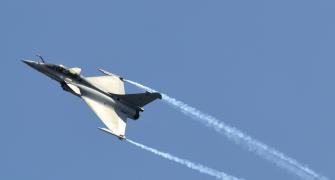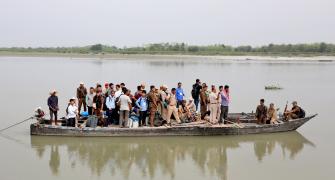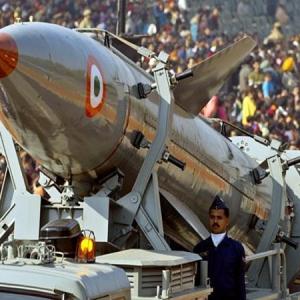India has a new Defence Minister: Nirmala Sitaraman, the nation's first woman Raksha Mantri.
'An expanding army, rising salaries due to the 7th pay commission, and raised pensions due to OROP are consuming money at the cost of badly needed bulletproof jackets, rifles, artillery, submarines, warships and fighter aircraft,' notes Ajai Shukla.

The defence allocations, presented as part of the Union Budget on February 1, 2017, highlighted the drawbacks that plague our defence planning.
Once again, the military emerges as an over-manned, poorly equipped, early 20th century force; with a bloated salary bill that leaves little for modernising a vast inventory of obsolescent equipment.
The depressing surrender of Rs 7,000 crore (Rs 70 billion) of capital budget underlines again our structural incapability to spend even the inadequate allocations we lament.
The discussions on the Budget make it evident that the political and strategic elite and the public remain largely oblivious to the continuing and dangerous hollowing out of the last resort of the State.
Using a methodology where allocations under disparate heads are extrapolated and tabulated in a common format, so that comparisons are made on an apples-to-apples basis, the chart (below) dis-aggregates the Budget allocations to the three armed services: The army, the navy and the air force.

*Excludes budget for Border Roads Organisation, but includes Rashtriya Rifles and National Cadet Corps
** Capital budget for services only, excludes allocations for DRDO and Ordnance Factories
^ Excludes budget for Coast Guard, but includes for Joint Staff
The year's allocations to the services amount to Rs 328,000 crore ($48.82 billion), or 91 per cent of the total defence budget of Rs 359,854 crore ($53.56 billion).
The remaining 9 per cent, which is off the chart, includes spending on the Defence R&D Organisation, the Ordnance Factory Board and the defence ministry -- including the Border Roads Organisation, Coast Guard and, mystifyingly, the Jammu & Kashmir Light Infantry, a regular infantry group.
Next year, as part of its continuing effort towards defence budget transparency, the government could consider merging Coast Guard allocations as a sub-head in the navy's budget, and JAK LI allocations into the army's budget.
The central problem in defence spending, which is evident from the last three columns (H, I and J) of the chart, is the crowding out of equipment procurement by steadily rising manpower costs.
An inexorably expanding army, rising salaries due to the Seventh Central Pay Commission, and raised pensions due to One Rank, One Pension are consuming money at the cost of badly needed capital procurement of bulletproof jackets, rifles, artillery, submarines, warships and fighter aircraft.
In 2015-2016, when only 8 per cent of the army's budget was buying new kit, the government boosted the army's capital allocations by Rs 7,500 crore (Rs 75 billion), following that with a Rs 3,000 crore (Rs 30 billion) increase in 2016-2017 and now Rs 1,500 crore (Rs 15 billion) next year.
Even so, a salary and pensions bill that consumes an eye-popping 72 per cent of the army's overall Budget, leaves no more than 11 per cent for new equipment.
Even the navy and air force, which traditionally spent more than half their budgets on new equipment, have been pegged down by the 7th CPC and OROP.
In the coming year, the navy will spend just 47 per cent of its money on capital procurement, despite a serious shortage of capital warships.
Only the IAF will spend more than half its budget on modernisation, thanks to a Rs 5,000 crore (Rs 50 billion) infusion to pay for last year's purchase of 36 Rafale fighters.
It should worry planners that an army engaged 24x7x365 on an active Line of Control, in counter-insurgency operations and in staggeringly hostile terrain conditions, makes do with a substantially lower modernisation budget than an air force that faces less immediate challenges.
Nor is this likely to change, going by the 14th Finance Commission recommendations that focus mainly on meeting manpower expenses.
It is noteworthy that finance ministry bureaucrats justify the inadequate capital allocations with the argument the military is unable to spend its allocated capital budget anyway.
This is technically correct: Most years, the defence ministry returns several thousand crores of unspent capital rupees, or transfers them to the revenue head.
But the well-known reason is that finance ministry officials impose an informal slowdown in according approvals as the year draws to a close, causing funds to lapse, and the deficit to appear in a rosier light.
The military, the victim in this game, can only watch helplessly since any significant expenditure requires the ministry or Cabinet sanction.
Individual services can sanction expenditures only up to Rs 150 crore (Rs 1.5 billion), while the defence minister can spend Rs 500 crore (Rs 5 billion); the finance minister up to Rs 1,000 crore (Rs 10 billion); and the Cabinet sanction is needed for any procurement larger than that.
Unclogging the system and preventing the services from being held hostage by tortuous approvals require the military's financial powers to be urgently and significantly raised.
Separately, accountability must be fixed for delays in finalising procurement proposals.
Technology provides for this; radio frequency identity tags, affixed to each procurement file, could identify how much time it has spent in each office up the approvals chain -- which routinely extends to months.
For years, the defence ministry has blithely ignored blatant violations of its own approvals timelines. This must end.
At a broader level, the military -- especially the army -- needs to be co-opted into a concerted process of reducing manpower to free resources for equipment acquisition.
The generals must be given ironclad assurances that manpower cost savings would be added onto the modernisation budget.
A culture of realistic long-term planning must be promoted by providing funding assurances well into the future, so that key planning documents, like the 15-year Long Term Integrated Perspective Plan, are anchored in financial realities rather than remaining empty wish lists that slip back at the end of each financial year.











